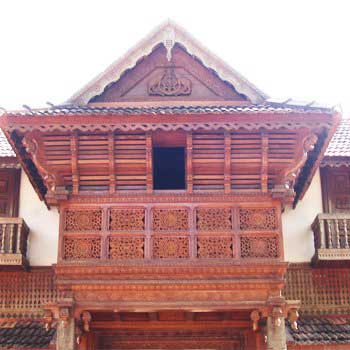Discover the Splendor of Padmanabhapuram Palace: A Masterpiece of Kerala Architecture in South India

The Royal Mansion – Padmanabhapuram Palace, a stunning creation reflecting Kerala architecture, has been added to the tentative “UNESCO World Heritage Sites” list in South India. This remarkable 16th-century wooden structure is nestled within the confines of Padmanabhapuram Fort, not far from Thuckalay town in Kanyakumari. You will find it along the road leading from Kulasekaram Thuckalay, about 20 km from Nagercoil & roughly 65 kilometres from Trivandrum.
Housing a plethora of traditional timber constructions, this palace stands within an ancient granite fortress extending nearly four kilometers. It sits gracefully at the base of the Veli Hills, part of the scenic Western Ghats. The palace dates to around 1601 CE, built under the reign of Iravi Varma Kulasekhara Perumal who governed Travancore between 1592 CE and 1609 CE.
It underwent significant enhancements around 1750 by Anizham Thirunal Marthandavarma (1706 -1758), known for his pivotal role in modernizing Travancore. King Marthanda Varma dedicated his realm to Sree Padmanabha—Vishnu's incarnation—& ruled as Padmanabha dasa or God's servant. Thus originated the name 'Padmanabhapuram', or 'City of Lord Padmanabha.'
By 1795 CE, when Travancore’s capital was relocated to Trivandrum, Padmanabhapuram Palace had seen its zenith. Nonetheless, it continues as an iconic example of Kerala’s architectural brilliance. Its vast complex showcases distinctive features characteristic of traditional Kerala style.
Inside you'll discover splendid rosewood carvings & sculpted decor filling its antique interiors. The palace houses unique 17th and 18th-century murals alongside marvels like mahogany musical bows, windows paneled with coloured mica & royal chairs adorned with Chinese carvings. Additionally, features such as 'Thaikkottaram' or Queen Mother’s palace boasts ceilings painted vibrantly & woodwork showcasing no fewer than 90 floral designs.
One cannot miss the Durbar Hall with its glistening black floor crafted uniquely from egg white mixtures, jaggery lime, burnt coconut, charcoal & river sand combination; here too are granite tubs cooling dairy products like curd and buttermilk beside secret passages & a medicinal four-poster bed in the King’s bedroom. Numerous mural paintings illuminate scenes alongside ever-lit brass lanterns dating back to the 18th century.
Visitors often find themselves captivated by this glimpse into royal opulence once thriving under Travancore’s rule. Despite being located in Tamil Nadu's Kanyakumari district today, it is managed by Kerala Government.
For those interested, visiting hours are set from 9:00 am to 500 pm daily except on Mondays, Wednesday mornings, and national holidays—pack your sense of wonder for a journey through time at this architectural treasure!
5 FAQs about Padmanabhapuram Palace
What is Padmanabhapuram Palace known for?
Padmanabhapuram Palace is renowned for its exquisite Kerala architecture, traditional timber constructions, and intricate rosewood carvings. It showcases unique features such as 17th and 18th-century murals, a Durbar Hall with a black floor made from natural materials, and the Queen Mother’s palace with vibrant painted ceilings.
Where is Padmanabhapuram Palace located?
The palace is located within Padmanabapuram Fort, near Thuckalay town in Kanyakumari, Tamil Nadu. It is about 20 km from Nagercoil and approximately 65 kilometers from Trivandrum.
What are the visiting hours and entry restrictions for Padmanabhapuram Palace?
The palace is open to visitors from 9:00 am to 5:00 pm daily, except on Mondays, Wednesday mornings, and national holidays.
What historical significance does Padmanabhapuram Palace hold?
Built around 1601 CE and enhanced significantly in the mid-18th century, the palace reflects the architectural brilliance of Kerala and the modernization efforts of King Anizham Thirunal Marthandavarma. It served as the capital of Travancore before it was moved to Trivandrum in 1795 CE.
What are some unique features and artifacts found in Padmanabhapuram Palace?
The palace houses several unique artifacts, including mahogany musical bows, windows paneled with colored mica, royal chairs with Chinese carvings, a medicinal four-poster bed in the King’s bedroom, and numerous mural paintings from the 17th and 18th centuries. The Durbar Hall's black floor and ever-lit brass lanterns from the 18th century are also notable highlights.